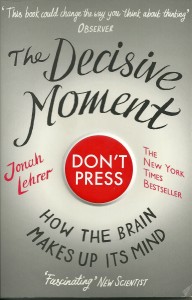The one-sentence summary
There is a thin line between a good and bad decision, and making good decisions requires both sides of the mind – rational and irrational – so it’s not an either/or choice.
WHAT THE BOOK SAYS 
- This book is about how the brain makes up its mind. How do we make decisions? And can we make better ones? It depends on the situation.
- This is another contribution to the seemingly endless Behavioural Economics debate, and it suggests, not for the first time, that we can learn a lot from neuroscience.
- There is a thin line between a good and bad decision, as most of us have found out. Making good decisions requires both sides of the mind. It’s a combination of rational and irrational, and not an either/or choice.
- Plato imagined the mind as a charioteer (the rational brain) pulled by two horses (our emotions, and ‘of an ignoble breed’).
- Freud imagined the id (a factory of crude desires) and the ego (the conscious self and rational brain).
- But it has since been discovered that emotion is crucial to making decisions. Without the emotional brain, a cricketer would not be able to react fast enough to play a shot. Reason without emotion is impotent.
- Dopamine is the neurotransmitter that helps to regulate all of our emotions – too much and we are overwhelmed, too little and we are miserable.
WHAT’S GOOD ABOUT IT
- Successful education (experience) is the ability to learn from mistakes. Unless you experience the unpleasant symptoms of being wrong, your brain will never revise its models.
- Loss aversion is one of our innate flaws. In the human mind, bad is stronger than good.
- In pressurised situations, good decisions can only be made if the prefrontal cortex manages emotions to create a state of ‘deliberate calm’. This means the calm person is always thinking about what they should think about.
- The conscious brain can only hold about seven pieces of data at any one moment – so much for multitasking.
- The brain can easily be confused by mental accounting – for example, changing the frame of reference so that you eat more M&Ms just because someone made the scoop bigger.
- Anchoring is another culprit: students asked to name their social security number before an auction unintentionally framed their bids in relation to those (random) numbers.
WHAT YOU HAVE TO WATCH
- As usual for behavioural economics, there is a series of anecdotes based on pilots in critical situations, American football players missing shots, and poker players winning and losing.
- If you have read a few other BE books, you’ll have read about almost all the experiments mentioned here.
